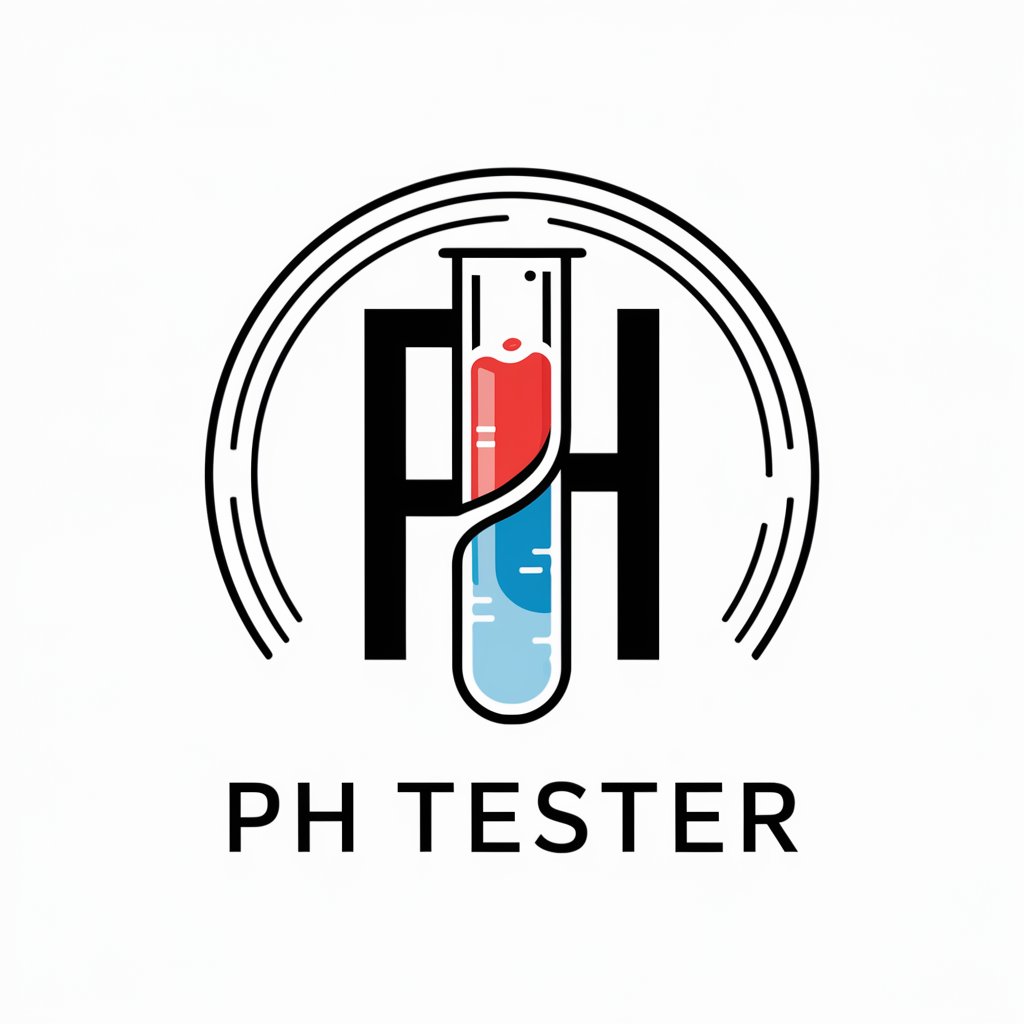
pH - pH Level Insight

Hello! I'm here to help you understand pH levels.
Deciphering pH with AI
Can you explain the significance of pH levels in...
How do pH levels affect...
What is the typical pH range for...
Why is it important to measure pH in...
Get Embed Code
Introduction to pH
pH stands for 'potential of hydrogen' and measures the acidity or alkalinity of a solution on a scale of 0 to 14. A pH of 7 is neutral, below 7 is acidic, and above 7 is alkaline (basic). The pH scale is logarithmic, meaning each whole pH value below 7 is ten times more acidic than the next higher value and each whole pH value above 7 is ten times more alkaline. This scale is crucial in various scientific and industrial fields because even slight changes in pH can significantly affect the properties of a substance and how it interacts with other substances. For example, in environmental science, monitoring the pH of water bodies can help assess pollution levels and aquatic ecosystem health. In medicine, the pH of blood and other bodily fluids is closely regulated, as deviations can indicate or cause health issues. Powered by ChatGPT-4o。

Main Functions of pH
Environmental Monitoring
Example
Assessing the health of aquatic ecosystems by measuring the pH of lakes and rivers.
Scenario
Environmental scientists monitor the pH of water bodies to identify pollution sources. For example, a sudden drop in pH might indicate acid rain effects, leading to measures to reduce emissions of sulfur dioxide and nitrogen oxides.
Agricultural Applications
Example
Determining the suitability of soil for growing specific crops.
Scenario
Farmers and agronomists measure soil pH to decide on crop selection and fertilization strategies. Certain crops thrive only within specific pH ranges, and adjusting soil pH can optimize nutrient availability and crop yield.
Industrial Processes
Example
Maintaining the correct pH in pharmaceutical manufacturing to ensure product stability and efficacy.
Scenario
In pharmaceuticals, precise pH control is vital during manufacturing processes to ensure the stability and efficacy of drugs. Slight deviations can lead to ineffective or unsafe products, highlighting pH measurement's role in quality control.
Medical Diagnostics
Example
Using pH measurements to diagnose medical conditions, such as acidosis or alkalosis.
Scenario
Healthcare professionals measure the pH of blood and other bodily fluids to diagnose conditions like metabolic acidosis, where decreased pH indicates an excess of acid in the body, or metabolic alkalosis, indicated by an increased pH.
Ideal Users of pH Services
Environmental Scientists
Environmental scientists benefit from pH measurements to monitor and manage water quality, study acid rain's effects, and assess the overall health of ecosystems.
Farmers and Agronomists
This group uses pH knowledge to manage soil conditions, ensuring optimal growth conditions for crops and making informed decisions on fertilizer use to adjust soil pH levels accordingly.
Industrial Chemists
Chemists in various industries, such as pharmaceuticals, food and beverage, and chemical manufacturing, rely on pH measurements for quality control, ensuring that products meet safety and efficacy standards.
Healthcare Professionals
Doctors, nurses, and laboratory technicians use pH as a diagnostic tool, assessing patient health through the pH of blood and other bodily fluids to detect, diagnose, and manage conditions related to body fluid imbalances.

Using pH Information Effectively
Initiate Exploration
Begin your journey at yeschat.ai for a comprehensive introduction to pH, offering a free trial that requires no sign-in or subscription to ChatGPT Plus.
Understand pH Basics
Familiarize yourself with the pH scale, which ranges from 0 to 14, where 7 represents a neutral solution, below 7 indicates acidity, and above 7 signifies alkalinity.
Identify Application Areas
Determine the specific context in which you wish to apply pH knowledge, such as environmental monitoring, food science, healthcare, or chemical research.
Utilize pH Measurement Tools
Select the appropriate tools for measuring pH, such as pH meters, litmus paper, or pH indicator strips, based on your specific requirements and precision needed.
Apply and Analyze
Apply your understanding of pH in practical scenarios, analyzing the results to make informed decisions or to further your research or project goals.
Try other advanced and practical GPTs
Grand Oral STAV PF
Empowering STAV Students with AI

Venture Visionary
Empowering startups with AI-driven insights for growth and social good.

MacTech Guide
AI-powered MacBook troubleshooting.

WindowsGPT
AI-powered Windows support at your fingertips

Ellie PA
Empowering your productivity with AI

KuuluisuuskoneGPT
Craft Your Brand's Story, Powered by AI

Marketing PH
Empowering Your Marketing with AI

Academic PI
Empowering research with AI-driven insights

Ultimate Business Advisor
Empowering Businesses with AI-driven Insights

SocialSphere: Social Media Magic Unleashed
Empowering Social Media Success with AI

Outley
Revolutionizing Personal Style with AI

Pogoda
Bringing AI to Weather Forecasting

In-depth Q&A on pH
What is pH and why is it important?
pH measures the acidity or alkalinity of a solution, ranging from 0 (highly acidic) to 14 (highly alkaline), with 7 as neutral. It's crucial in various fields, including biology, chemistry, medicine, and environmental science, because it affects chemical reactions, biological processes, and the health of ecosystems.
How can pH affect human health?
The pH level of the body's internal environment, particularly the blood, is tightly regulated. Deviations from the normal pH range can affect metabolic processes and enzyme activities, leading to health issues like acidosis or alkalosis.
What role does pH play in environmental science?
pH is a key indicator of water quality and soil health. It affects the solubility of nutrients and pollutants, impacting plant growth and aquatic life. Monitoring pH is essential for assessing the impact of acid rain, pollution, and other environmental factors on ecosystems.
How is pH measured?
pH can be measured using electronic pH meters, which offer precise readings, or colorimetric methods like litmus paper and pH indicator strips. These tools rely on pH-sensitive dyes that change color based on the acidity or alkalinity of the solution.
Can pH vary within the human body?
Yes, different parts of the body have different pH levels to facilitate specific functions. For example, the stomach has a highly acidic environment (pH 1.5 to 3.5) to aid digestion, while blood maintains a slightly alkaline pH of about 7.35 to 7.45.





